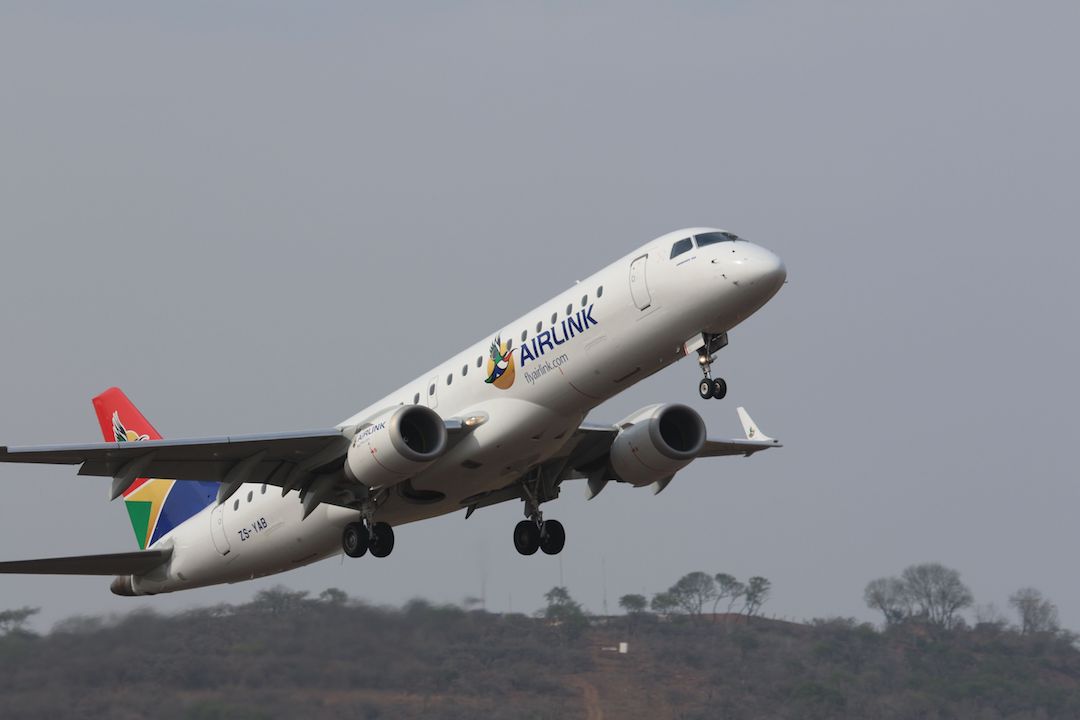Rodger fosters Airlink's flightpath
Navigating South Africa’s airline scene has never been more complex. The market has changed massively in the past four years, with many of the old-established carriers no longer in existence and newcomers keen to take their places.

Rodger Foster, CEO and MD of Airlink: IMAGE: Airlink
South Africa has also become a hunting ground for foreign airlines, thanks to South Africa’s generosity in liberalising its aviation market, says one of the country’s veteran airline bosses.
Rodger Foster, CEO and MD of regional carrier Airlink, says the country’s domestic landscape has changed out of all recognition since the pandemic. Flag-carrier South African Airways (SAA), once the nation’s dominant airline, is a shadow of its former self after having emerged from a lengthy restructuring under South Africa’s “business rescue” procedure.
SAA’s low-cost carrier (LCC) subsidiary, Mango, has collapsed, as have SAA’s regional operator South African Express (SAX) and British Airways franchise operation Comair.
In their place, LCC FlySafair has sprung to prominence, and newcomer Lift is also making inroads into the market.
FlySafair holds the dominant position on the country’s trunk routes and has around 60 per cent of the domestic market, while Airlink has around 20 per cent, with the remainder split between Lift, SAA and CemAir.
“It’s quite different within the region. If you look at the composition of the market before Covid, it was very different from where it is now. Airlink has stepped into the gap left by SAA, Comair and Air Namibia. All of that presented opportunities, during and subsequent to Covid.”
Seizing those opportunities has resulted in Airlink now having the most comprehensive route map and greatest flight frequencies within southern Africa, Foster said, although he reckons that the market has still only recovered to around 80 per cent of pre-pandemic levels.
To service this market, Airlink’s aircraft have changed in recent years. Gone are the 29-seater BAe Jetstream 41 turboprops that served as the company’s smallest aircraft, which has evolved into an all-jet Embraer fleet.
This consists of 27 Embraer Regional Jets – 16 37-seat ERJ135s plus 11 44-seat ERJ140s – for thinner routes, with the trunk sectors being served by three newer-generation E170s (74 seats), E190 (98 seats) and six E195 (107 seats).
The three E170s are in the process of being retired and will be replaced by four marginally larger E175s. However, the latter model will also only be there on a temporary basis, said Foster.
The E195s, three of which came from an aborted order from Belarussian state carrier Belavia and three from lessor AerCap, are in different seating configurations, but will be standardised on the 107-seat layout, consisting of 11 business-class and 96 economy-class seats.
The E190s have only nine seats fewer, which Foster conceded was: “Not much of a gap. Over time, we will probably want to standardise on 98 and do something different with the 195s.”
Airlink’s main domestic competitor, low-cost carrier FlySafair, operates Boeing 737-800s and “that sets the benchmark from a unit cost perspective, which gives them the ability to lead on [ticket] price.”
As a result, Airlink will have to follow suit and operate narrowbodies with more capacity than the Embraers, said Foster.
“We need to do it at some point. We need to be mindful of timing. The narrowbody market has firmed considerably, mainly because the challenges of the [Pratt & Whitney] geared turbofan engine that has slowed down production of the [Airbus] A320neo, and [Boeing 737] MAXs have had their challenges as well.”
Delays in delivering new-generation single-aisle jets, together with engine problems once in service have produced great demand for earlier-generation 737-800s and -700s, which have mature, more reliable power plants.
With the price of the used, older-generation aircraft having hardened considerably, “We don’t want to be locked into long-term leases that, over time, become uncompetitive compared to the benchmark.”
However, said Foster, Airlink would make the step up to the larger aircraft “when the time is right”.

He praised the E190 as “an exceptionally competent aircraft” that could cope with a wide variety of routes, including the long over-sea sector to the UK South Atlantic island dependency of St Helena and the equally demanding airport at Pietermaritzburg, whose runway is short, narrow and undulating, as well as being set within surrounding high ground.
The E190’s range and payload/range capabilities are good he added and its smaller size compared to narrowbodies meant that it could be operated at high frequencies to destinations.
As for the smaller ERJ135s and 140s, “We have great reliability out of the aircraft and they’re good assets. Just on that basis, we see there’s still economic life in the fleet. They’re excellent as route development vehicles and for providing good frequency.”
The fleet has perhaps six to eight more years ahead of it. When they eventually retire, the E175 could be their possible replacement, “but we have to think how close the 175 is to the 190; you want to create an entry-gauge aircraft.
“Fleet planning is quite a topical thing at Airlink at the moment. There are lots of options to what [the future fleet] looks like.”
Equally important is the future shape of Airlink’s route network. Most markets are fully serviced, but Airlink sees certain routes in the region where it can compete by leveraging the power of its network, for example, by funnelling traffic into its hubs at Johannesburg and Cape Town, then connecting it to flights to more distant regional centres such as Nairobi or Dar-es-Salaam.
The company is expanding beyond South Africa, but is cautious about setting up new bases in its own name. In Namibia, it has taken a 40 per cent stake in a joint venture with newcomer Fly Namibia, whose management has adopted Airlink’s franchise system. “We hope that will be viable in the not-too-distant future and we think that could be repeatable.”
Over time, Foster believes that Fly Namibia will set up a series of what he describes as ‘mini-starburst’ networks out of locations such as Walvis Bay, perhaps to places such as Victoria Falls and Harare.
Looking further afield, Foster has reservations about the current state of Africa’s civil aviation scene. “It’s a vast continent of 55 countries, 55 sets of rule and regulations, 55 regulators, more than 400 airlines. It has 1.4 billion people, but average GDP is less than $2,000. That means that not many people on the continent yet have the ability to move around it, or beyond it, by air.
Even in South Africa, only a fraction of the country’s approximately 70 million population can afford to fly.
The Single African Air Travel Market (SAATM), agreed by most of Africa’s nations, is designed to sweep away many of the bureaucratic regulations and restrictions hampering air transport on the continent.
But while the intention of creating an ‘Open Skies’ system where airlines can fly wherever they want is laudable, the system is flawed, Foster said.
Many countries have availed themselves of the new rights under SAATM to fly in and out of South Africa, but had not allowed the same freedom to South Africa to operate in their own countries.
“We need to be pushing back on that. We have to get access to markets where we’ve been blocked, or block those that have already availed themselves of access to South Africa. There needs to be equality and, at the moment, there isn’t.”
There have been rumours for some time that major Middle East carrier Qatar Airways plans to make a significant investment in Airlink. Foster is notably cautious on this matter, saying that the best person to answer questions on this is Qatar Airways Group CEO, Badr Mohammed Al Meer.
“We don’t have a binding contract with any of our 36 airline partners. That’s not to say we’re not talking to any or all of them.”
Stay up to date
Subscribe to the free Times Aerospace newsletter and receive the latest content every week. We'll never share your email address.


